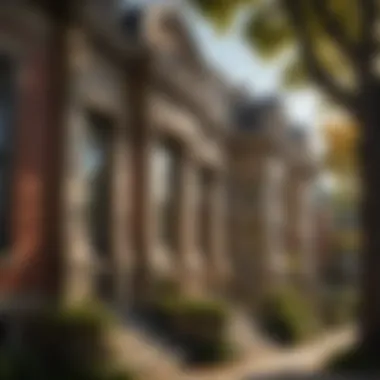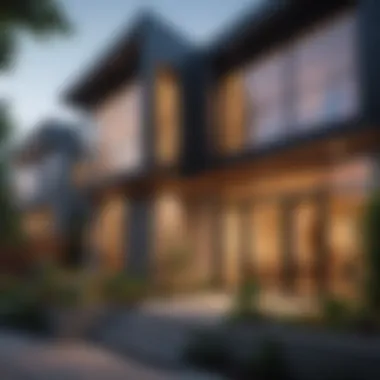Capitol Hill Homes: Architecture and Real Estate Trends


Intro
Capitol Hill is a notable neighborhood, well-known for its vibrant character and rich history. Its homes reflect a variety of architectural styles that have evolved over time, each telling a unique story. Understanding this neighborhood offers valuable insights into both the past and present landscape of urban living in the capital. This analysis will explore the key elements that make Capitol Hill's residential options appealing, addressing their architectural distinctions, historical context, and current real estate trends.
Feature Spotlight
Exceptional Architectural Designs
Capitol Hill is a showcase of architectural styles, ranging from Victorian to Colonial Revival. The meticulous craftsmanship of each home stands as a testament to the eras they represent.
- Victorian houses often feature ornate details, including decorative trim and asymmetrical facades. They evoke a sense of nostalgia, transported from an earlier time.
- Federal-style homes present a more restrained elegance. Their symmetry and understated decoration provide a classic appeal that has endured through generations.
- Contemporary designs are also sprinkled throughout the neighborhood, reflecting the current trends in urban architecture while integrating with traditional styles.
Each of these styles contributes to the overall charm of Capitol Hill, attracting those who appreciate historical significance and aesthetic variety.
Unique Decor Elements
The interior decor of Capitol Hill homes is often as diverse as their architecture. Many residents have embraced contemporary trends while preserving historical artifacts. Key features include:
- Restored fireplaces as a central living element.
- Custom moldings that highlight architectural details.
- Innovative use of space designed for modern lifestyles.
These elements not only enhance the aesthetic appeal but also reflect the personalities of the homeowners, creating spaces that are both functional and inviting.
Location Highlights
Must-Visit Neighborhoods
Capitol Hill is not just about its homes; its neighborhoods offer unique experiences worth exploring. Key areas include:
- Lincoln Park, known for its green spaces and community vibe.
- Eastern Market, vibrant with local vendors and eateries.
- Barracks Row, which features popular dining and shopping options.
Each of these locales adds to the dynamic nature of the Capitol Hill experience, making it attractive for residents and visitors alike.
Cultural and Historical Significance
What sets Capitol Hill apart is its rich historical context. The area has been a part of significant events in U.S. history, contributing to its cultural depth.
- The presence of numerous embassies and historical buildings gives residents a sense of being at the heart of national and international affairs.
- Community events and festivals frequently celebrate this heritage, fostering a sense of belonging among residents.
Overall, understanding the cultural and historical significance of Capitol Hill enhances appreciation for its residential landscape.
"Capitol Hill is not just a collection of homes; it is a living tapestry of history and modernity. Each street corner captures a fragment of the American story."
Prelude to Capitol Hill
Capitol Hill is a neighborhood that embodies a rich tapestry of history, architectural diversity, and real estate dynamics. Understanding this area's background is pivotal for anyone interested in its homes or the community itself. The significance of Capitol Hill extends beyond its picturesque streets. It reflects broader socio-political changes and cultural trends that have shaped Washington D.C. over the years. Thus, when we delve into the architectural styles and the ongoing movements in real estate, it connects the past to the present.
A comprehensive examination of Capitol Hill provides various benefits. It reveals the unique characteristics that make this neighborhood appealing. Furthermore, it educates prospective buyers about the home's value and investment potential. A thorough analysis highlights key considerations, such as neighborhood amenities and demographic shifts. By exploring these factors, readers will gain a nuanced understanding of what Capitol Hill offers.
Geographic Overview
Capitol Hill is located to the east of the United States Capitol, a landmark that symbolizes the heart of the nation’s political life. This prime location features a mix of residential and commercial developments, making it attractive for many residents. The neighborhood is bordered by major avenues and streets, facilitating convenient access to other parts of D.C. Neighborhood parks and community spaces enhance the aesthetic and practical aspects of living here.


The landscape is characterized by tree-lined streets and charming squares that create a sense of community. The proximity to public transportation allows residents to easily reach downtown, making commuting manageable. Moreover, the geographic layout encourages walking and biking, aligning with an increasing urban trend toward sustainable living. A balance of urban vibrancy and suburban calm defines the geographic identity of Capitol Hill.
Historical Context
The history of Capitol Hill is intricate and deeply entwined with the development of Washington, D.C. Initially, this area was primarily residential, with an influx of families in the 19th century. The architectural evolution began with Federal style homes, which laid the groundwork for what we see today. However, it was during the Victorian era that Capitol Hill witnessed a significant transformation. Ornate details and complex designs became popular, reflecting the aspirations of its residents.
Throughout the 20th century, Capitol Hill continued to adapt. The impact of World War II brought changes to housing and demographics. As suburbanization took hold, many families moved further out, leading to a decline in some areas. However, the late 20th and early 21st centuries saw a resurgence in interest for Capitol Hill, fueled by an appreciation for its historical significance and architectural variety.
The preservation of homes and community establishments has become a priority, showcasing the neighborhood’s commitment to maintaining its heritage while accommodating modern needs. This ongoing evolution illustrates the blend of tradition and contemporary living that defines Capitol Hill today.
Architectural Styles of Capitol Hill Homes
Understanding the architectural styles of Capitol Hill homes is essential for appreciating the neighborhood's character and history. Each style reflects the cultural and historical shifts that shaped the area. Furthermore, knowledge of these styles benefits potential buyers who seek authenticity or specific aesthetic qualities in their new homes. Capitol Hill homes offer a range of styles, which tells a story of evolution in design preferences and construction methods over the years.
Victorian Influences
Victorian architecture is prominently characterized by its ornate details, asymmetrical shapes, and vibrant colors. Capitol Hill boasts numerous homes built during the Victorian era, which spanned from 1837 to 1901. This style often features high-pitched roofs, decorative trim, and large porches. The significance of these homes lies not only in their beauty but also in their reflection of the period's socio-economic status and artistic ambitions.
Notable elements of Victorian homes include:
- Textured surfaces such as shingles or brick patterns.
- Bay windows that expand living spaces and allow for more natural light.
- Gabled roofs that create visual interest and diversity in roof lines.
These stylistic features contribute to Capitol Hill’s distinct aesthetic appeal, making it a draw for those interested in historical architecture.
Colonial Revival
The Colonial Revival movement began in the late 19th century and peaked in the early 20th century. This architectural style sought to evoke the nation’s colonial past. In Capitol Hill, these homes exhibit characteristics like symmetrical facades, evenly spaced windows, and classical columns.
Key design features of Colonial Revival homes include:
- Rectangular shapes with simple roofs, often gabled.
- Columns and pilasters providing grandeur and homage to classical Greek and Roman architecture.
- Prominent entryways with detailed doorways and sidelights that emphasize the entrance.
Colonial Revival homes represent a desire to recapture the ideals of the nation’s founding and offer a sense of stability and tradition. This style resonates strongly with both homebuyers and historians alike.
Modern Incorporations
Modern architecture in Capitol Hill is increasingly visible, blending traditional elements with contemporary design. These homes often emphasize open spaces, minimalism, and energy-efficient features. Trends in modern design signal a shift towards functionality while still respecting historical context.
Prominent features of modern homes include:
- Large windows that promote natural light and connect interiors to outdoor spaces.
- Sustainable materials, aligning with environmental considerations and energy efficiency.
- Clean lines and geometric shapes that stand in contrast to ornate styles from the past.
Modern incorporations into Capitol Hill's architectural landscape enhance its diversity and cater to a wide range of preferences in homebuying. Adopting modern elements ensures that the neighborhood continues to evolve while maintaining its rich heritage.
The blend of various architectural styles in Capitol Hill not only enriches the neighborhood's visual narrative but also reflects the dynamic nature of its community and its residents’ living standards.
Capitol Hill's Community and Lifestyle
The community and lifestyle of Capitol Hill play a crucial role in the allure of this neighborhood. As Washington D.C.'s oldest residential neighborhood, it exudes a sense of depth and character that reflects its rich history. This section explores the various elements that make Capitol Hill a unique place to live, emphasizing its cultural significance, residential dynamics, and transportation networks.
Cultural Significance
Capitol Hill is more than just a collection of homes; it is a vibrant community imbued with cultural heritage. The area hosts a diverse mix of residents, each contributing to the overall fabric of the neighborhood. This cultural mosaic is manifested in local events, art galleries, and shops. Stage the annual Capitol Hill House & Garden Tour, where residents showcase their unique living spaces and gardens, fostering community connections.


Wider cultural expressions can be seen through the array of local cuisines and shops along Eastern Market. With everything from artisanal bread to unique crafts, one can experience the community's commitment to supporting local businesses. The neighborhood's cultural significance is also underscored by its proximity to national monuments and institutions, giving residents a constant reminder of their historical roots in US governance.
"Cultural diversity strengthens a community, providing unique perspectives and fostering creativity."
Residential Dynamics
The residential landscape of Capitol Hill is equally compelling. A blend of architectural styles and home sizes caters to a diverse array of homeowner preferences. From Victorian row houses to elegant Colonial Revivals, the architecture reflects the area's eclectic history. This variety not only attracts families but also singles and retirees, adding to the neighborhood's dynamic residential profile.
Moreover, community dynamics here often hinge on active participation. Many residents engage in neighborhood associations that tackle local issues, ensuring that the voices of the community are heard. This spirit of engagement can lead to a greater sense of belonging and a stronger connection among neighbors, further enriching the residential experience.
Accessibility and Transportation
Accessibility is a key factor in the lifestyle of residents in Capitol Hill. The neighborhood benefits from its robust public transportation options, including Capitol South Metro station and multiple bus routes. This connectivity makes commuting to downtown Washington D.C. convenient, both for work and leisure activities.
The layout of Capitol Hill encourages walkability, which is another benefit for residents. Parks such as Lincoln Park and Eastern Market provide green spaces for leisure and activities, essential for a balanced lifestyle. Bicycle lanes and pedestrian-friendly streets enhance mobility, catering to those who prefer alternative transport methods. Thus, accessibility shapes not just the residential choices but also the daily routines of Capitol Hill's inhabitants.
In summation, Capitol Hill's community and lifestyle are as multifaceted as its homes. The cultural significance, dynamic residential patterns, and strong transportation network create a vibrant living environment that appeals to many individuals and families seeking a fulfilling urban experience.
Navigating the Real Estate Market
Navigating the real estate market in Capitol Hill is essential for anyone interested in this vibrant neighborhood. The complexities of home buying and selling require an understanding of market dynamics, property values, and future trends. Buyers should be aware of how external factors, such as economic conditions and interest rates, influence local real estate.
Understanding the market can help inform decisions, from setting a fair price to knowing when it's the right time to buy or sell. Knowledge of neighborhood attributes, past sales, and emerging developments can enhance one's position within this competitive landscape.
Market Trends
Recent market trends indicate a noticeable shift in buyer preferences and behaviors. Capitol Hill has seen increased demand for homes with modern amenities while also retaining historical charm. Many buyers seek properties that combine functionality with aesthetic value. Reports suggest that median home prices in the area have experienced an upward trajectory due to limited inventory and high interest from potential homeowners.
Also, younger buyers are more actively engaging with the real estate market. This demographic tends to prefer townhouses and smaller condominiums as opposed to larger single-family homes. Recognizing these trends can equip prospective buyers with the information needed to make informed decisions.
"Staying informed about changing market conditions is vital. It can determine the outcome of a buyer's or seller's objectives in Capitol Hill's real estate landscape."
Price Ranges and Affordability
In Capitol Hill, price ranges can vary widely based on property type, location, and size. Typically, homes can start from around $600,000 for smaller condos, reaching upwards of $2 million for larger, historic residences. Understanding this range helps buyers set realistic budget expectations.
Affordability is an ongoing concern for many, especially first-time buyers. It is essential to factor in not just the purchase price but also additional costs such as property taxes, insurance, and maintenance. Many financial advisers recommend that homebuyers allocate no more than 30% of their income towards housing costs to maintain overall financial health.
Investment Potential
The investment potential in Capitol Hill continues to attract various types of investors. The area's real estate generally holds its value well, making it an appealing option for those looking to purchase income-generating properties. Rental demand remains strong, particularly with young professionals and families drawn to the area's cultural and historical significance.
Investors should also keep an eye on proposed urban development projects, as these can affect property values. Studies show that investments in infrastructure and public amenities can elevate real estate prices and enhance the appeal of the neighborhood.
In summary, navigating Capitol Hill's real estate market requires diligence, research, and an understanding of multiple factors. This knowledge not only aids in making educated decisions but can also maximize opportunities for success in home investment.
Practical Considerations for Prospective Buyers
When looking to purchase a home in Capitol Hill, prospective buyers must consider various practical aspects that can significantly influence their experience. This neighborhood, with its eclectic mix of architecture and vibrant community, brings unique opportunities and challenges. Understanding these factors will empower buyers to make informed decisions, ensuring a smooth transition into their new home.
Inspection and Appraisal


A thorough inspection and appraisal are essential steps in the home-buying process. Buyers should prioritize hiring a qualified home inspector to evaluate the property’s condition. Inspections reveal potential issues such as plumbing problems, electrical failures, or structural concerns. Knowing these details can help buyers avoid costly surprises later.
Additionally, an appraisal provides an unbiased assessment of the home's market value. This process is crucial, as it ensures that the purchase price aligns with the current market trends in Capitol Hill. A professional appraisal can also assist in negotiations, giving buyers leverage to request price adjustments based on findings from the inspection report.
Financing Options
Understanding financing options available for Capitol Hill homes is crucial for prospective buyers. Traditional mortgages, FHA loans, and VA loans each have distinct eligibility requirements and benefits. Buyers should evaluate their financial situation to determine the best fit. For example, FHA loans may benefit first-time homebuyers due to lower down payment requirements.
It is advisable for buyers to consult with a mortgage broker or financial advisor. They can provide insights into local lending practices and recommend options tailored to individual circumstances. Moreover, keeping an eye on interest rates is essential, as they can fluctuate and impact overall affordability when purchasing a home in this competitive market.
Renovation and Upkeep
Capitol Hill is known for its historically significant homes, many of which may require renovations or updates. Buyers should assess their willingness to undertake these projects. Renovations can enhance a property's value but come with time and costs. It is prudent to create a budget and timeline for any planned improvements.
Regular upkeep is also vital, especially in older homes. Being proactive with maintenance can prevent major issues in the future. This includes routine tasks such as roof inspections, plumbing checks, and exterior repairs. Homebuyers should consult local contractors for reliable service recommendations in the Capitol Hill area.
"A well-maintained home not only adds to the aesthetic appeal but also ensures lasting value in the real estate market."
These practical considerations are vital for anyone interested in moving to Capitol Hill. Having a clear strategy about inspections, financing, and renovations will help buyers navigate the unique real estate landscape of this historic neighborhood.
The Future of Capitol Hill Homes
The future of Capitol Hill homes lies at the intersection of historic preservation and modern urban development. As the neighborhood evolves, it faces specific challenges and opportunities that require careful balance. Homebuyers and investors must consider factors such as urban planning, sustainability, and community needs. Understanding these elements is crucial for anyone interested in Capitol Hill's residential landscape. The decisions made today will shape the character and livability of the area for generations to come.
Urban Planning Initiatives
Urban planning initiatives in Capitol Hill are designed to preserve the unique character while accommodating growth. Local government and planning organizations often engage with residents to ensure that development aligns with community values. Recent projects include mixed-use developments that allow for residential, commercial, and recreational spaces in close proximity.
Some key aspects of these planning initiatives include:
- Zoning Changes: Adjustments to zoning laws can facilitate higher density housing without compromising historical aesthetics.
- Public Transportation Enhancements: Improving access to public transit will ease congestion and increase walkability.
- Green Spaces: New parks and community gardens provide recreational spaces for residents, crucial for urban living.
These efforts aim to make Capitol Hill a more attractive choice for homebuyers while keeping its rich heritage intact.
Sustainability Efforts
Sustainability is becoming increasingly important in urban neighborhoods, including Capitol Hill. As more residents advocate for environmental responsibility, the demand for greener living solutions grows. Various initiatives focus on reducing environmental impact and enhancing quality of life.
Prominent sustainability efforts in Capitol Hill include:
- Energy-Efficient Buildings: New constructions are increasingly incorporating energy-efficient designs, reducing utility costs for homeowners.
- Transit-Oriented Development: Encouraging homebuyers to utilize public transit reduces carbon footprints.
- Community Initiatives: Local groups promote eco-friendly practices, such as community recycling and green waste programs.
By prioritizing sustainability, Capitol Hill homes can not only appeal to environmentally conscious buyers but also contribute to a healthier planet.
"The future of Capitol Hill's residential landscape is a blend of honoring history and embracing innovation, crucial for both tenants and the environment."
Epilogue: The Allure of Capitol Hill Living
The conclusion signals the apex of understanding regarding Capitol Hill homes. This section holds importance as it encapsulates the unique blend of elements that define the neighborhood's charm. Living in Capitol Hill means embracing a rich history, stunning architectural styles, and an engaged community. The amalgamation of these factors creates not just houses but a sense of home.
Summation of Key Points
In reviewing Capitol Hill, several salient points become clear. First, the architectural diversity is a hallmark of the area. From Victorian to Colonial Revival and modern designs, each style contributes to the neighborhood's visual narrative. Second, the historical significance provides context that enhances the living experience. Choosing to reside here is choosing to be part of a story that dates back decades. Additionally, the community aspect deserves mention. This neighborhood is not just about residences; it is about the people who inhabit them and the relationships formed here. Furthermore, real estate trends reflect a steady demand and investment potential, making this location appealing for buyers. As for the practical considerations surrounding homeownership, knowledge of market trends and financial options ensures informed decisions.
Final Thoughts for Homebuyers
For prospective buyers, Capitol Hill presents both opportunities and considerations. Research is paramount. Understanding market trends and recent sales provides clarity. Budgeting for the ongoing maintenance and understanding local regulations contribute to a successful homeownership experience. Additionally, consider the cultural richness and community events that underline Capitol Hill's lifestyle. This area offers not just property but a quality of life shaped by history and an active neighborhood.
In essence, Capitol Hill is a noteworthy choice for homebuyers seeking a dynamic environment infused with historical resonance and community spirit. By weighing these particular aspects, potential homeowners can assess if the allure of Capitol Hill aligns with their desires for urban living.







